Types of modern individual septic tanks for a private house
If the dwelling is not connected to the central sewage system, owners should take care of their own wastewater treatment. For this purpose, a device of several chambers is installed in which the liquid settles and the solid particles decompose. There are several types of septic tanks for a private house, suitable for different conditions. When choosing take into account productivity, climate, cost and principle of operation.
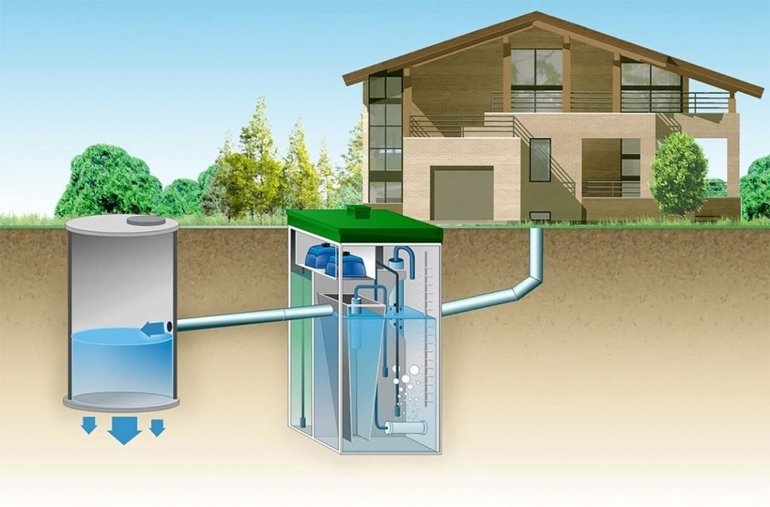
Aerobic and anaerobic stations
According to the type of biodegradation, individual bioseptics for continuous use are divided into 2 groups. Anaerobic treatment occurs without oxygen. Structurally, a septic tank consists of 2 or more chambers, however, the waste is not completely cleaned. In order for the liquid to be used for irrigation, additional filtration is required. The system may be a well or a filtration field. After completing the entire cycle, the liquid becomes almost transparent, odorless, and then you can water the garden with it.
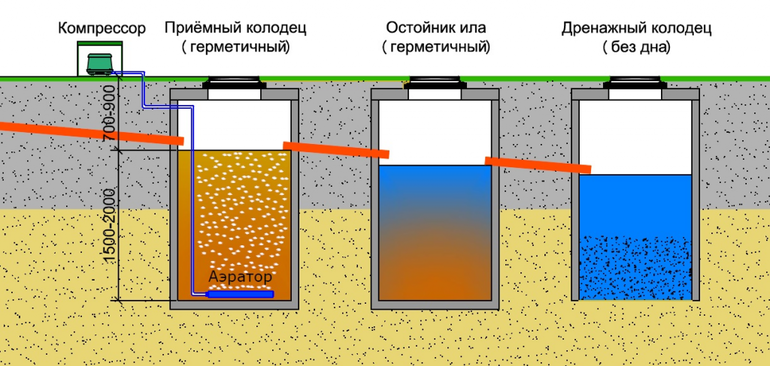
A more expensive and efficient design is a local treatment plant, arranged on the same principle as large sewage systems. VOC consists of several cameras. In the first case, sedimentation takes place, in the second - biological decomposition in closed chambers with the participation of bacteria.
Once in the third compartment, the effluents go through the stage of processing by microorganisms. This process is carried out with oxygen access. Pollution cleaves into inert organic compounds., after which they enter the next chamber. There they again settle, as a result of the sludge settles to the bottom, from where the airlift pumps it.
The whole mass enters the stabilization compartment, where it is divided into liquid and dense parts. Less dense sludge enters the aerobic compartment again and goes through all stages a second time. A dense part of the waste accumulates in the stabilization compartment and is removed as necessary.
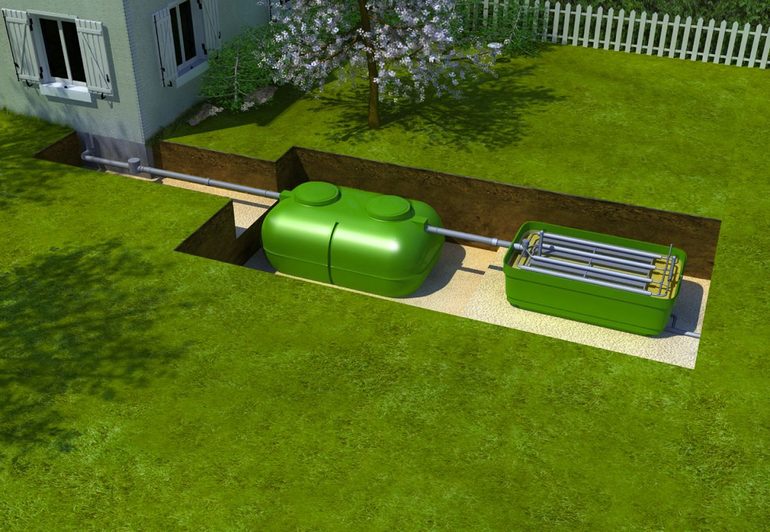
In addition to these varieties, there are drives that are not customary to separate into a separate group. Waste in them is not processed by microorganisms, but only settled. The simplest drive is a cesspool. The used liquid gets there and accumulates. As you fill the pit, you need to pump out the liquid along with the sludge from it. Another option is to dig and dig a new one in another place.
Electricity demand
There are septic tanks that cannot function without being connected to a power source. There are those that do not need electricity. Non-volatile devices are the simplest. In them, organic matter is oxidized without oxygen, and the effluents move from one tank to another due to gravity.
Volatile septic tanks operate only under the condition that the compressor supplies oxygen to the liquid waste. For a summer residence, it is better to choose another option, since the equipment needs to be constantly monitored. Waste is oxidized and moved from one tank to another. The compressor drives airlifts that pump the liquid fraction and activated sludge.
In some situations, anaerobic wastewater treatment plants also require electricity to drive compressors. An example is the location of a septic tank in an uneven area where water cannot move by gravity from one tank to another.
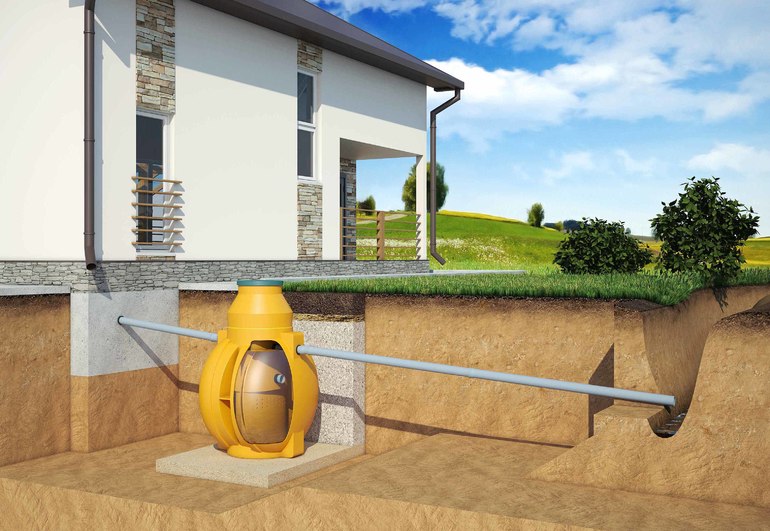
Materials for the construction of tanks
There are several materials suitable for the construction of treatment tanks, and each has both positive and negative features. Options of septic tanks for a country house:
- metal;
- plastic;
- concrete;
- wooden;
- brick;
- from tires.
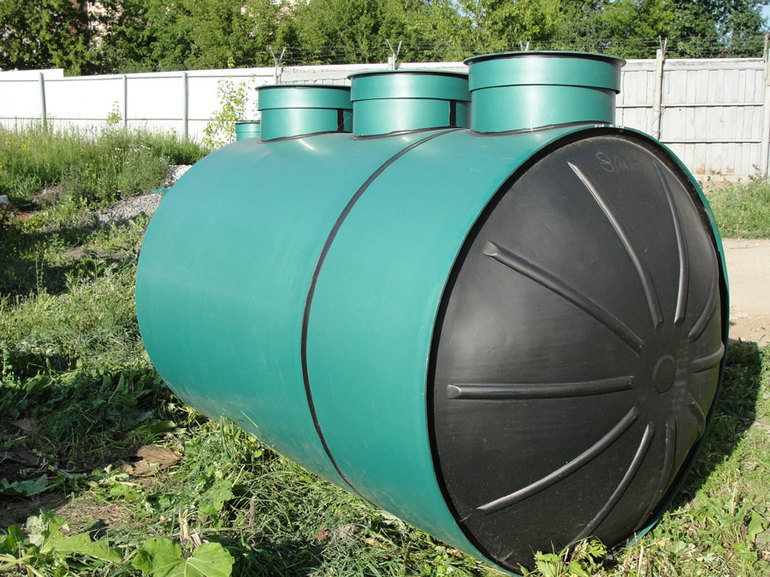
Plastic tanks are sold ready-made, but if desired, they are easy to make on their own. You will need eurocubes or pieces of plastic pipes of large diameter. Installation is carried out according to the same principle as when using concrete rings. The septic tank is lightweight, durable and airtight, while it looks pretty neat and can have any size.
A metal tank is welded from steel sheets. You can also install a finished tank. The need for metal products arises when the treatment plant needs to be installed at a great depth, where the plastic chamber will not withstand the pressure created by the soil. In order for the tank to last as long as possible, it is coated on the inside with a composition that protects the material from corrosion.
If the budget for the construction of a septic tank is small, it is worth considering the option of building from brick. In addition to the piece material, you will need the concrete mortar from which the base is built. Masonry is done using a solution, while the chambers can have rectangular or round contours.
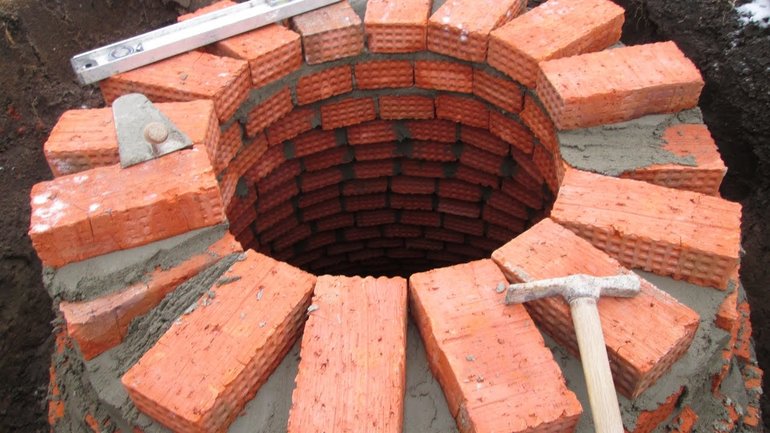
The brick septic tank is durable and lasts for decades. The downside is that the construction of the masonry is hard work, and it may not work out on its own. However, construction does not require the involvement of equipment, and this factor can become decisive in the case when access to the site is difficult or impossible.
In a relatively short time, a sewage treatment plant can be constructed of concrete rings. Products with a diameter of 1 m or more are used. The rings are delivered to the site and stored, and then with the help of a crane they are installed on one another. A place for the construction of a septic tank is prepared in advance. The disadvantage of such tanks is the likelihood of leaks at the junction of the elements.
Less common are septic tanks from tires and boards. Both options are not very reliable, while they can not be called durable and airtight. The boards rot over time and the structure collapses. Reservoirs from tires do not hold drains well, as a result, fluid seeps into the soil. The main danger is that in the spring, when the groundwater level rises, the site may be flooded with fetid liquid.
Septic selection criteria
The cheapest and simplest septic tank is plastic, the most durable, reliable and expensive is concrete. This approach to the selection of a treatment plant is simple, but it does not take into account many factors. Parameters from which to proceed:
- cost;
- durability;
- reliability;
- weather;
- required performance.

The capacity of a sewage treatment plant and the rate of waste treatment depend on the number of people living in a private house. It is necessary to take into account people who come to visit, as they also consume water, which then flows into the sewer. On average, 1 person spends 200 liters of fluid per day, and this should be taken into account when planning the volume of a treatment plant.
The liquid is cleaned within a few days, and for 3 days the effluents are in the tanks. Thus, the volume obtained by multiplying 200 liters by the number of residents, you need to triple. Example: for a family of 3 people you need a structure with a capacity of 2.4 cubic meters. m
The natural conditions include the climate, the prevailing weather in different seasons, the features of the relief and the composition of the soil. The depth of freezing of the soil determines how far the pipes should be from the surface. If you place them above the zero mark, the structure can shift when it will be affected by frost heaving forces. The task is simplified if you buy a finished tank, whose inlet is located below, and the neck is made elongated.

Installation of equipment should be carried out in a place where there is no risk of flooding during rains and melting snow. Preferably, the liquid can flow out of the last tank under the influence of gravity. If the terrain does not make it possible to carry out the installation in this way, care must be taken that the tank is equipped with a pump.
The type of soil matters because some soils expand when frozen. If the container is made of plastic or wood, it will not withstand the pressure. The best option for complex soil - tanks made of monolithic concrete or rings. Soil treatment on clay soil usually also causes difficulties. If possible, it is better to construct a treatment plant in a place where sandy soils prevail.
Features and price models
When planning the construction of a modern septic tank for a private house, you should not save money, since momentary benefits can turn out to be big expenses in the future. Popular septic tank models are good in that they provide a guarantee, during which the owner does not have to face difficulties due to the need to repair equipment. Considering which septic tanks to choose for a private house, you need to look at the equipment with the best characteristics, for a family of 5 people:
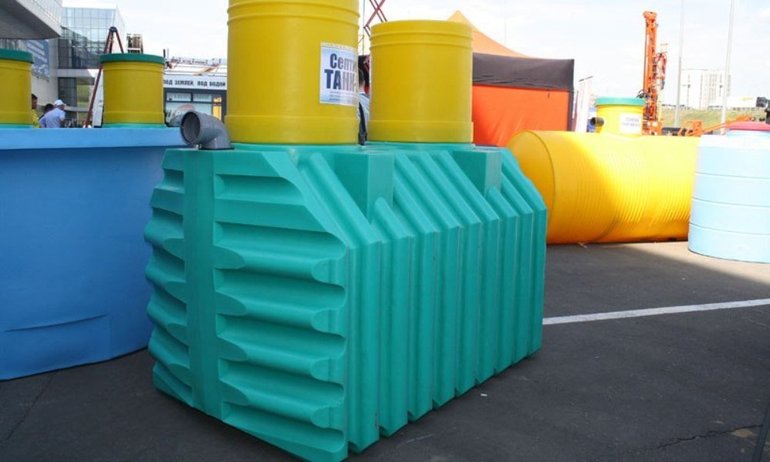
- "Tank 2.5". The cost of a fully equipped model is 36 thousand rubles or more, depending on the pricing policy of the seller. Soil treatment is provided.
- "Poplar 5". Full cycle biological treatment station. The model is also popular among owners of private houses, and it can be purchased for 72 thousand rubles (excluding installation costs).
- Topas. The price of this septic tank starts from 80 thousand rubles. He copes with the cleaning of household liquid waste.
If you need an inexpensive option for a summer residence, you should pay attention to the Triton Mini model with a capacity of 750 liters. Of the local treatment systems, Unilos Astra-5 is considered one of the most reliable.
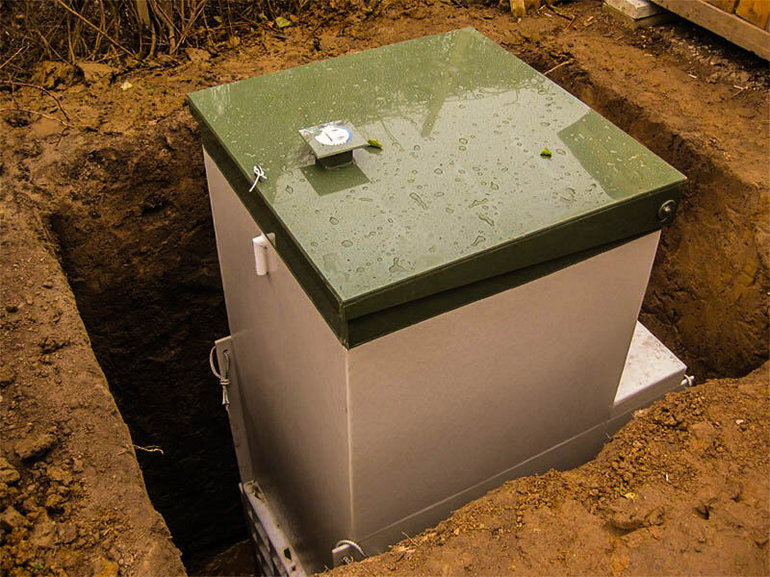
Installation and maintenance
Installation of tanks is carried out strictly according to the instructions. If there are no construction skills at all, it is better to choose a septic tank for a private house in the form of a finished structure. When the tanks are made independently, they first dig a hole, then mount the tanks. It is important that a sufficient distance is maintained to some objects, including:
- to the foundation of housing - 5 m;
- to wells and wells - 50 m;
- to trees - 3 m;
- to rivers and other reservoirs - 30 m.
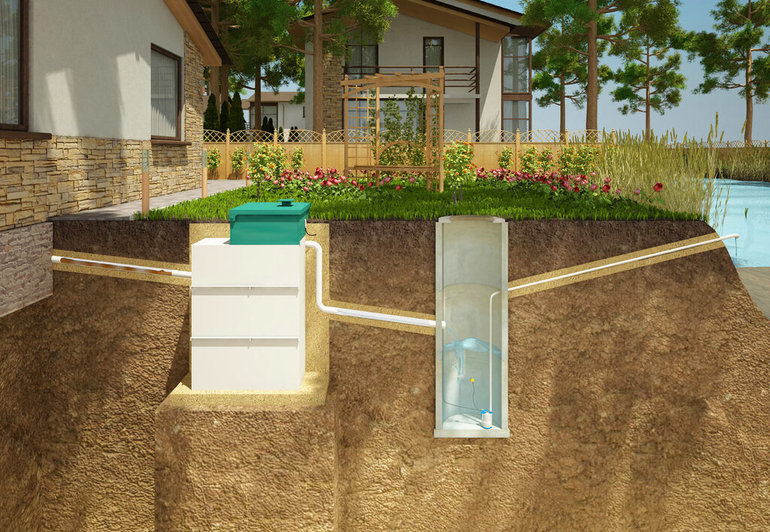
Filtration fields should not be located directly under the carriageways. Wells should be below freezing. What is it in a particular region, you need to clarify. The parameters are spelled out in SNIP 2.02.01−83.
Pipes are laid at a slope in pre-dug trenches, and tanks are installed in prepared pits. For concrete septic tanks, formwork is constructed, into which the mixture is then poured and waiting to dry.
The septic tank is mounted on a sand cushion, the thickness of which should be at least 10 cm. The containers should be oriented strictly horizontally. The next step is to bring and connect all the necessary pipes. After installation, the pipeline and chambers are covered with a sand-cement mixture, and the last 30 cm to the edge - with earth. After backfilling, you need to start operating the septic tank as soon as possible - this will immediately make sure that the system is functioning properly.
Maintenance of the tank is reduced to the regular removal of sludge. Once every 3 months you need to check how much it has accumulated. Dense substance is pumped out using a drain pump. The densest sediment, which accumulates over 1−2 years, is extracted by a sewage machine.
Every week or 2 times a month, it is necessary to check how the structure works, and this is primarily true for aerobic stations. If you do not want to do maintenance yourself, you can conclude a contract with a specialized company. Inspection and pumping, carried out in one day, will cost approximately 3500-4500 rubles.For 12 months, the total cost of maintenance will be about 15 thousand rubles, provided that the waste will be removed 1 time in 3 months.
- How to choose a vacuum cleaner taking into account the characteristics of the house and coatings?
- What to look for when choosing a water delivery
- How to quickly create comfort at home - tips for housewives
- How to choose the perfect TV - useful tips
- What to look for when choosing blinds
- What should be running shoes?
- What useful things can you buy in a hardware store
- Iphone 11 pro max review
- Than iPhone is better than Android smartphones



